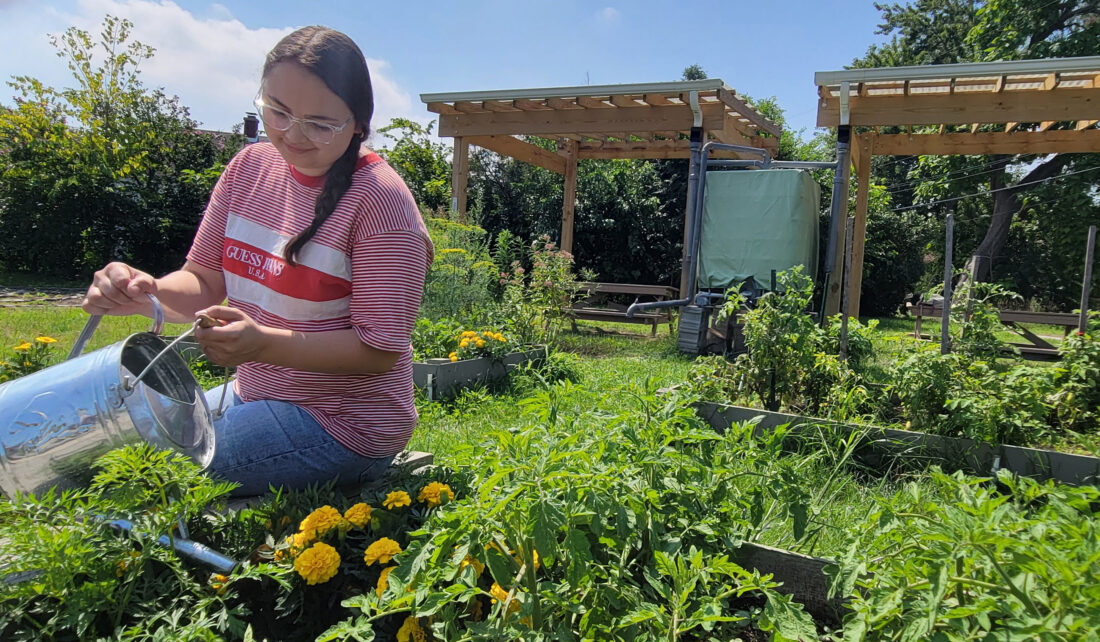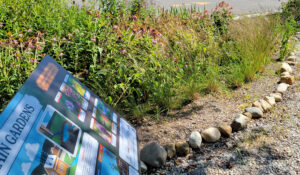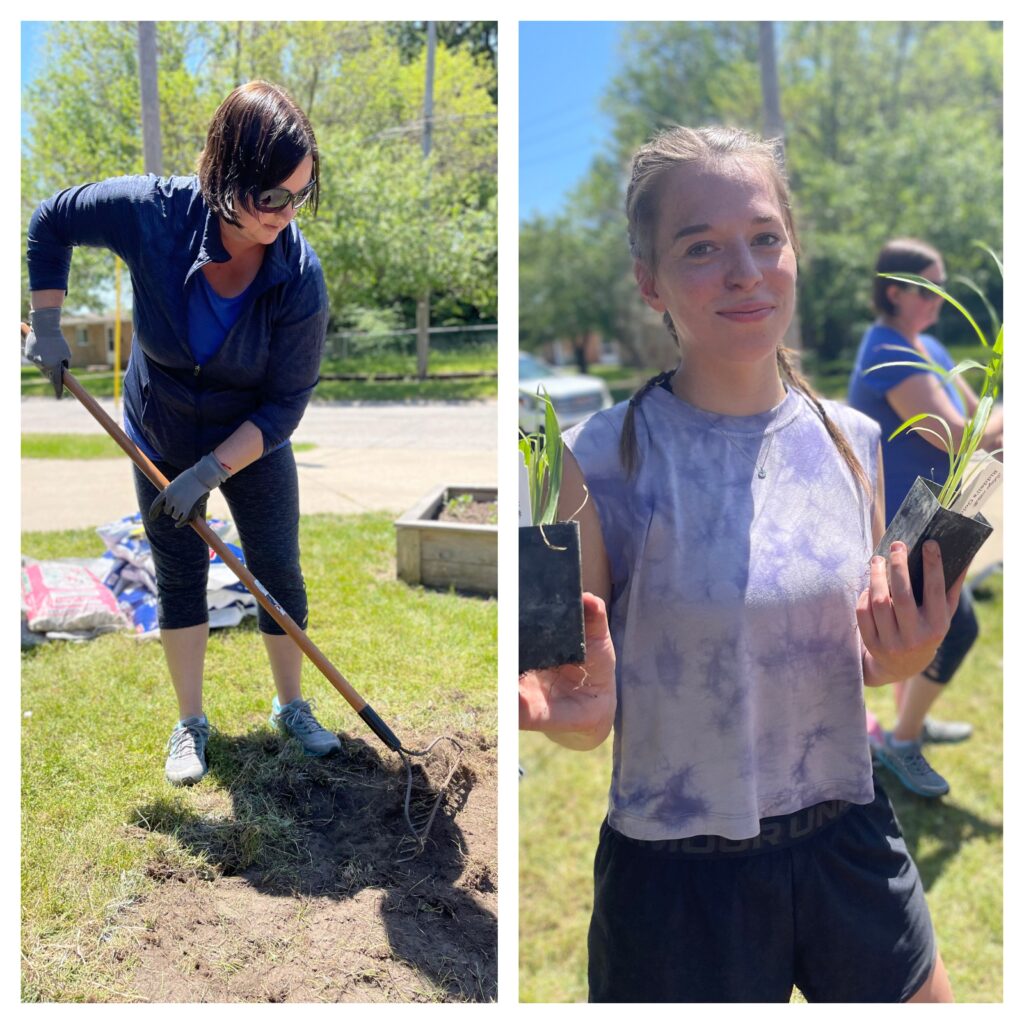
Conserving or growing the number of trees and other plants in our environment is not just a feel-good idea. Among many benefits, gardens and other greenspace can help reduce flooding, a major concern in the Midwest due to increasingly larger, more frequent storms, as well as expanding development that leaves rain nowhere to go.
Green infrastructure, such as rain gardens, allows rainwater to be absorbed where it lands.
Hazard Mitigation Planning
To provide on-the-ground support for incorporating green infrastructure, Illinois-Indiana Sea Grant (IISG) and Purdue University and University of Illinois Extension programs are helping inform the process as communities develop or update their Multi-Hazard Mitigation Plans or other resilience plans.
“This effort arose out of working with community groups and hearing that they have a need for these resources,” said Kara Salazar, IISG sustainable communities extension specialist, who led this work.
With funding from the Extension Disaster Education Network, the team developed a planning process that brings together existing plans and ordinances, GIS data, and input from focus groups and community engagement. In two communities, the project team and local participants worked together to identify current and future strengths, assets, and opportunities as they relate to natural hazards faced by the community, with an emphasis on nature-based solutions.
The team also used the new Green Infrastructure Optimization Tool, which, through visualizations, can help decision makers determine suitable placements for rain gardens and other nature-based options.
“It’s important that green infrastructure is located where it will be most effective and have the most impact,” said Salazar.

The rain garden near the courthouse in LaPorte, Indiana is part of a suite of green infrastructure practices installed throughout the city.
In an Indiana county that sits along Lake Michigan, the City of La Porte requested help from IISG as it set out to improve its stormwater management plan. In addition to two planning sessions, local stakeholders took part in the Rainscaping Education Program, which culminated in the installation of a demonstration rain garden in an underused park adjacent to city hall.
“The garden installation was part of a larger effort to build resilience in La Porte through updating ordinances and installing green infrastructure,” said Salazar. “The rain garden site absorbs a significant amount of stormwater runoff. It is part of a suite of green infrastructure practices installed throughout the city, including along a state highway redevelopment corridor.”
In Hancock County in Illinois, it was time to update the Multi-Hazard Mitigation Plan and the green infrastructure team was there to help the county and its municipalities explore possible nature-based solutions. This very rural county, with a total population that is less than the city of LaPorte, has limited resources to invest in infrastructure, green or otherwise.
Nonetheless, local decision makers see the writing on the wall.
“With a changing climate, the expectation is that major storms will be more frequent,” said Carolinn McKillip, Illinois Extension community and economic development educator. “Many communities that don’t have storm sewers to accommodate this much rain are looking to new construction as a way to incorporate nature-based solutions.”
As a result of IISG and Extension’s efforts in Hancock County, in several municipalities, the hazard plan includes creating policies and procedures to incorporate green infrastructure into future development. In fact, a project in Carthage is underway to build a new library and if funding is found, it will include a rain garden.
In nearby Nauvoo, local leaders, master gardeners, and other stakeholders took part in Rainscaping training and planted a rain garden of more than 1,500 square feet that runs along both sides of a highly traveled intersection.
Additionally, the City of La Harpe has several green infrastructure projects included in its hazard mitigation plan, again, if the city can secure funding. Local planners are also looking to transform abandoned land into something useful.
“They will explore using some vacant lots to reduce stormwater on La Harpe’s main streets downtown. Planners are talking about rain gardens, terracing, or permeable pavers and creating something like a pocket park,” said McKillip.
The work of Salazar, McKillip, and their team in the two states has led to the development of a toolkit that is a resource for communities in the Great Lakes region and beyond. With facilitation from Sea Grant or Extension, communities can access the agendas, activities, and presentations that provide guidance in incorporating green infrastructure as part of hazard mitigation planning.
“This summer’s weather should tell us that that we need to rethink the way we do things,” added McKillip. “Hopefully, efforts like this can help expand the knowledge base to everyone in our states and our communities on how to be more resilient to these extreme weather events that we’re facing.”
One Block at a Time
Flooding and other climate change impacts are the drivers of another community outreach project—for this one, IISG is collaborating with both Minnesota and Pennsylvania Sea Grant programs. With funding from the National Sea Grant Office, they formed a multi-community work team to address climate hazards in Michigan City and Hammond, Indiana; Duluth, Minnesota; and Erie, Pennsylvania, respectively.
“Communities or neighborhoods that are marginalized due to income insecurities and other social vulnerabilities are acutely experiencing multiple water-related climate challenges yet have the fewest means to respond,” said Salazar.
As part of this project, Minnesota Sea Grant developed the Ready for Rain One Block concept (adapted from the Center for Neighborhood Technology) to engage local government and residents in addressing the challenge of flooding. The idea is to develop community-planned green infrastructure projects in one city block, which can be duplicated across nearby blocks.

Kara Salazar, left, and IISG summer intern Payton Ginestra, right, help with the installation of a rain garden at the Smrt Community Center in Michigan City, Indiana.
In Indiana, IISG collaborated with the Smrt Community Center in Michigan City and the InnerMission Neighborhood Farm, managed by the Gate Church, in Hammond. Both sites have small community gardens, developed with help from Purdue Extension, to increase access to fresh vegetables for neighborhood residents. But at both sites, a sustainable water source was a challenge.
“At each location, we worked with the garden managers, neighbors, and site users to conduct focus groups, interviews, and site visits to collaboratively design a rainwater harvesting structure and a rain garden to catch any overflow,” said Salazar.
At the community garden site in Hammond, this year, instead of dragging five-gallon buckets of water to the garden, volunteers are able to fill up a watering can on site or use the garden hose to keep tomatoes, cabbages, collard greens, peppers, cilantro, and other produce plants properly watered. Nearby residents are welcome to take produce as needed and some are chipping in to help with weeding and other tasks.
The site has grown with the addition of a micro food pantry and a meditation labyrinth. Angelica Weaver, who founded the garden, is planning on adding a little free library and places for children to play.
“The work of Purdue Extension and Sea Grant has helped us become sustainable, which was a dream of ours since we started this project in 2020,” said Weaver. “Now we feel like we have the tools to continue the work that we’re doing for many years to come.”
One Block at a Time efforts in Indiana, Minnesota, and Pennsylvania have also been compiled into a soon-to-be released toolkit for broader use. This collection of resources takes one through the process, including background assessments as well as community visioning, scoping, and implementation.
Environmental Justice Communities
Small, rural communities that have suffered from industrial pollution or other environmental or economic setbacks will soon have some support to make things better. Through a nationwide Environmental Protection Agency (EPA) grant, IISG will provide technical assistance to help underserved Indiana communities define and implement their visions.
“We will especially be connecting with communities that have difficulties applying for federal grants because of their size and limited staff support,” said Salazar. The focus will be on funding opportunities available from EPA and the Department of Energy.
Salazar and her team will engage in outreach that will likely take the form of workshops. “The focus may include grant writing, grant management or facilitation work, and other skills that can help communities successfully fund their impactful environmental projects.”
The work in Indiana will be part of a larger grant that includes Illinois and other EPA Region 5 states and tribes.
Illinois-Indiana Sea Grant is a partnership between NOAA, University of Illinois Extension, and Purdue University Forestry and Natural Resources, bringing science together with communities for solutions that work. Sea Grant is a network of 34 science, education and outreach programs located in every coastal and Great Lakes state, Lake Champlain, Puerto Rico and Guam.

